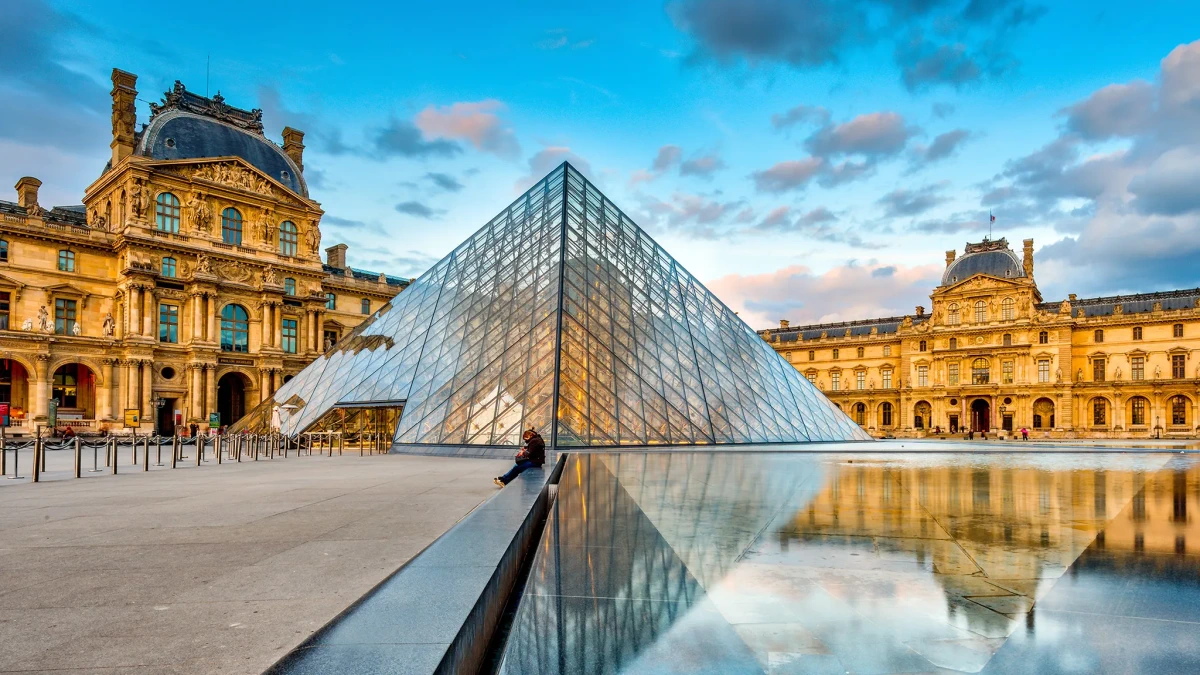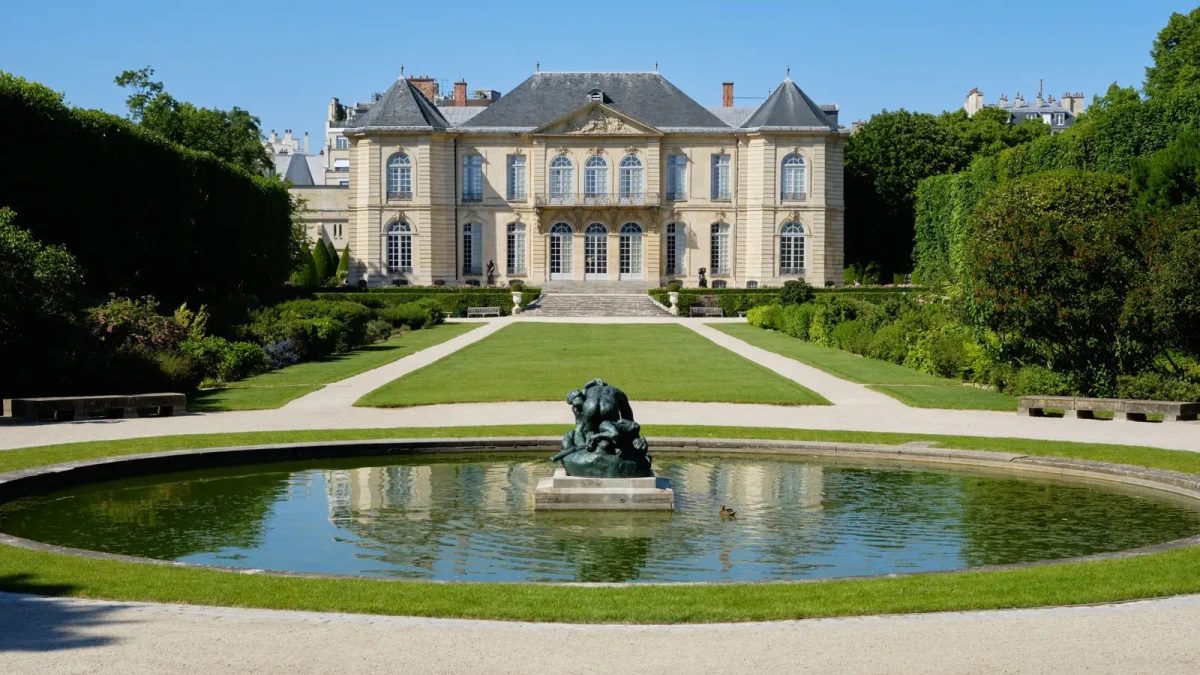Paris, the City of Love, is home to numerous architectural marvels, each with its own unique charm. One such breathtaking monument is Sacré Coeur Paris, a basilica that stands tall on the highest point of the city.
With its stunning white facade, awe-inspiring views, and rich history, Sacré Coeur Paris is a must-visit destination for travelers seeking to immerse themselves in the cultural and spiritual essence of the French capital. In this article, we will delve into the enchanting beauty of Sacré Coeur Paris, exploring its history, architectural significance, nearby attractions, and more.
Note: This article contains affiliate links. In case you purchase something through one of these links, we may receive a small commission at no extra cost for you. Thank you for helping us keep creating the free content on this website!
Sacré Coeur Paris: A Testament to Faith and Artistry
Sacré Coeur Paris, meaning "Sacred Heart" in English, is a Roman Catholic basilica dedicated to the Sacred Heart of Jesus. It is located in the Montmartre district, one of the most vibrant and artistic neighborhoods in Paris. This architectural gem was designed by Paul Abadie and construction began in 1875, only to be completed in 1914 due to various setbacks, including the two World Wars.
The Architectural Marvel
The beauty of Sacré Coeur Paris lies not only in its spiritual significance but also in its architectural grandeur. The basilica boasts a unique blend of architectural styles, primarily inspired by Byzantine and Romanesque influences. The result is a harmonious blend of architectural elements that make Sacré Coeur a unique and awe-inspiring sight. Its stunning white travertine facade stands out against the Parisian skyline, making it an iconic landmark visible from many parts of the city.
One of the most distinctive features of Sacré Coeur Paris is its dazzling white exterior, made of Château-Landon stones that exude a luminous quality. This choice of material gives the basilica a striking appearance, especially when bathed in the warm glow of the sun. The use of white stones was not only an aesthetic decision but also serves a practical purpose - they constantly self-cleanse, ensuring that the basilica remains pristine and radiant throughout the years.
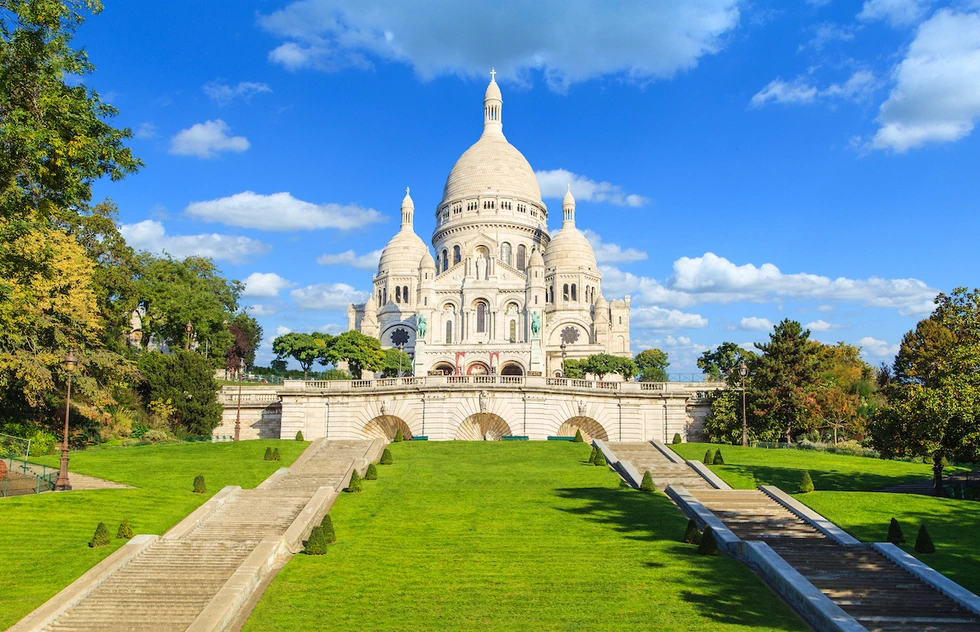
As visitors approach Sacré Coeur, they are greeted by an imposing flight of stairs leading to the entrance. This grand staircase, consisting of 237 steps, symbolizes the spiritual ascent and the arduous journey towards faith. Climbing these steps, one can appreciate the intricate details and elaborate decorations that adorn the facade of the basilica. Delicate sculptures, intricate carvings, and intricate mosaics showcase the craftsmanship of the artists who dedicated their skills to bring the architect's vision to life.
Upon entering Sacré Coeur Paris, visitors are immediately struck by the vastness and serenity of the interior space. The high vaulted ceilings, supported by robust columns, create a sense of grandeur and transcendence. The play of light and shadow through the magnificent stained glass windows adds an ethereal quality to the atmosphere, bathing the interior in a kaleidoscope of colors. The focal point of the basilica is the immense mosaic of Christ in Glory, which covers the entire apse and serves as a visual representation of divine transcendence and redemption.
Apart from its architectural magnificence, Sacré Coeur also holds deep religious significance for many people. It is a place of worship, prayer, and pilgrimage, attracting countless visitors seeking solace and spiritual enlightenment. The basilica's location on Montmartre, the highest point in the city, further adds to its spiritual aura, as it offers a panoramic view of Paris, reminding visitors of the interconnectedness between the earthly and the divine.
Sacré Coeur Paris has witnessed numerous historical events, both joyous and tragic, throughout its existence. It has been a site of national celebrations and a place of remembrance during times of conflict. Its presence has been a source of hope and resilience for the people of Paris, a symbol of strength and faith.
The Sacre-Coeur welcomes more than 10 millions visitors per year, while the Notre Dame welcomes about 13 millions visitors per year.
History of Sacré Coeur Paris
The history of Sacré Coeur Paris is deeply intertwined with the tumultuous events that shaped the city and the nation. Let's take a journey through time to understand the significance of this magnificent structure.
Construction and Symbolism
The origins of the Sacré-Coeur Paris date back to the late 19th century when France was reeling from the aftermath of the Franco-Prussian War and the Paris Commune. These conflicts had left the nation divided and wounded, and there was a yearning for spiritual revival. In 1870, the National Vow Association was established, vowing to build a church dedicated to the Sacred Heart of Jesus as an act of penance and devotion. The project gained momentum, and a competition was held to select the architect who would design the basilica.
Paul Abadie, a distinguished French architect, won the competition, and construction on the Sacré-Coeur Paris began in 1875. Abadie drew inspiration from various architectural styles, combining elements of Romanesque and Byzantine influences to create a unique masterpiece. The basilica's distinctive features include its Romanesque apse, Byzantine domes, and a grand bell tower that soars 83 meters into the sky.
The construction of the Sacré-Coeur faced numerous challenges, both practical and political. The site on the Butte Montmartre was known for its unstable ground, making it difficult to lay foundations. Additionally, political tensions surrounding the project emerged. Some Parisians, particularly left-wing factions, criticized the church as a symbol of the conservative establishment and an attempt to reassert religious dominance in a secular society. These criticisms resulted in periodic interruptions to construction, further prolonging the basilica's completion.
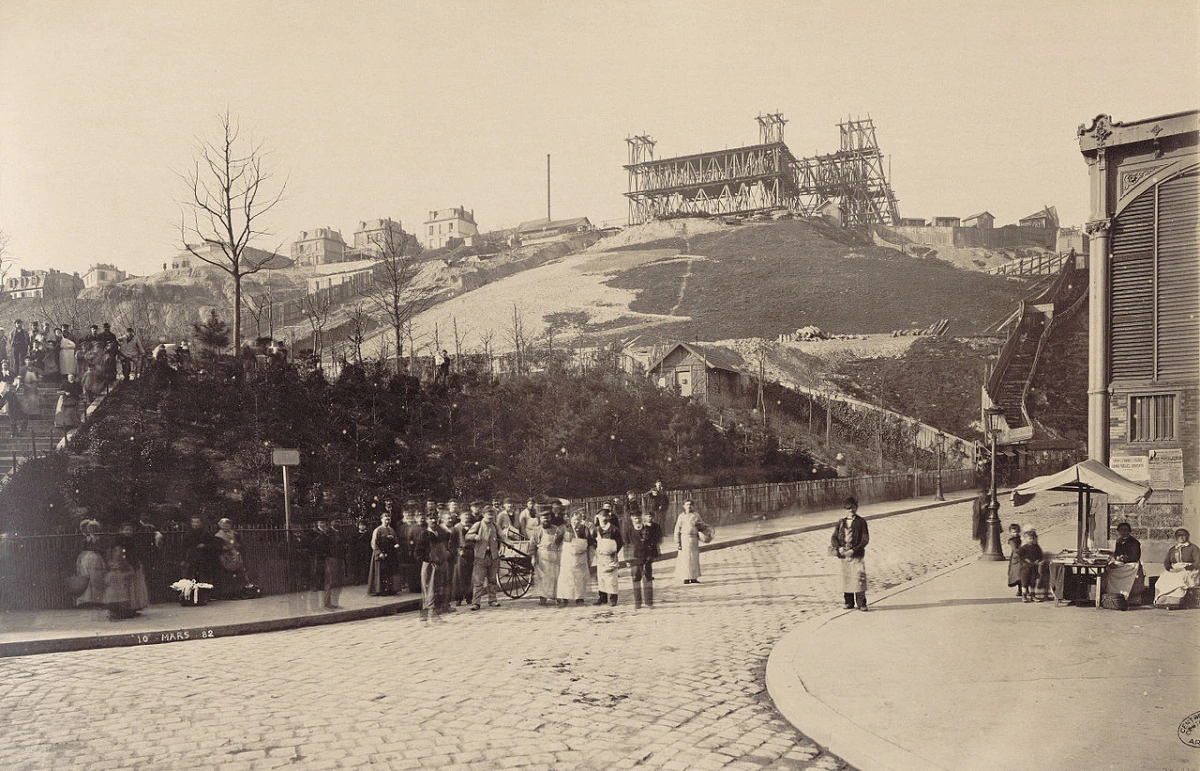
Despite these setbacks, the Sacré-Coeur was finally completed in 1914, nearly four decades after its inception. The basilica's consecration took place in 1919, following the end of World War I, with the intention of honoring the fallen soldiers and praying for peace. The white stone used for its construction, called travertine, was chosen not only for its aesthetic appeal but also for its ability to self-clean when exposed to rain, ensuring that the basilica retains its luminous appearance over time.
Since its completion, the Sacré-Coeur has stood as a beacon of hope and resilience for the people of Paris. It has witnessed the highs and lows of the city's history, including the German occupation during World War II and the social and political upheavals of the 20th century. The basilica has become a place of pilgrimage, attracting visitors from all over the world who seek solace, inspiration, and a glimpse into the city's rich heritage.
Today, the Sacré-Coeur continues to play a significant role in the religious and cultural life of Paris. Its grandeur and architectural splendor make it a popular tourist destination, offering panoramic views of the city from its dome and attracting crowds of visitors eager to experience its spiritual ambiance. It is a site of worship, with regular masses and religious ceremonies taking place within its walls, providing a place of prayer and reflection for both locals and visitors alike.
The Sacré-Coeur Paris stands as a testament to the enduring power of faith, the resilience of a city, and the artistry of human endeavor. Its rich history, intertwined with the events that have shaped France, serves as a reminder of the importance of cultural heritage and the role of architectural landmarks in preserving collective memory. The Sacré-Cœur will forever remain an emblem of Paris, an enduring symbol of hope, and a source of inspiration for generations to come.
Preservation and Restoration
Over the years, Sacré Coeur Paris has undergone several preservation and restoration efforts to maintain its pristine condition. The basilica is a testament to the dedication of countless artisans, architects, and conservators who have worked tirelessly to preserve this architectural masterpiece for future generations to admire.
First Restoration (1923-1924)
The initial restoration of Sacré-Coeur took place only a decade after its completion. It was necessitated by the structural deterioration caused by weathering and pollution. The restoration efforts aimed to address the degradation of the facade, repair damaged sculptures, and reinforce weakened elements. The delicate balance between preserving the original design and implementing necessary repairs was carefully maintained, ensuring the basilica's longevity while retaining its aesthetic integrity.
Ongoing Maintenance and Repairs
Sacré-Coeur Paris requires constant maintenance to counteract the effects of time, pollution, and weather. The basilica's limestone exterior is particularly susceptible to the corrosive impact of air pollution. Regular cleaning, repair of damaged masonry, and reinforcement of weakened structures are vital to the long-term preservation of this architectural gem. These ongoing efforts ensure that visitors today can still marvel at the stunning features of Sacré-Coeur as intended by its creators.
The Savoyarde is the largest bell in France, weighing almost 19 tonnes, and was pulled by 28 horses at a time from Annecy to Paris.
The Restoration of the Dome (1987-1989)
One of the most significant restoration projects in recent history was the refurbishment of Sacré-Coeur's famous dome. Completed between 1987 and 1989, this undertaking focused on repairing cracks, stabilizing the structure, and replacing worn-out materials. The meticulous process involved extensive research, historical documentation, and the use of traditional construction techniques to maintain the authenticity of the original design. The restoration of the dome not only enhanced the basilica's visual appeal but also improved its structural stability.
Conservation and Preservation Efforts
Preserving the historical and artistic heritage of Sacré-Coeur extends beyond visible repairs. Conservation efforts encompass the protection of stained glass windows, frescoes, sculptures, and other priceless artworks housed within the basilica. Climate control measures, periodic inspections, and expert restoration techniques are employed to safeguard these delicate elements from degradation, ensuring that future generations can experience the magnificence of Sacré-Coeur Paris.
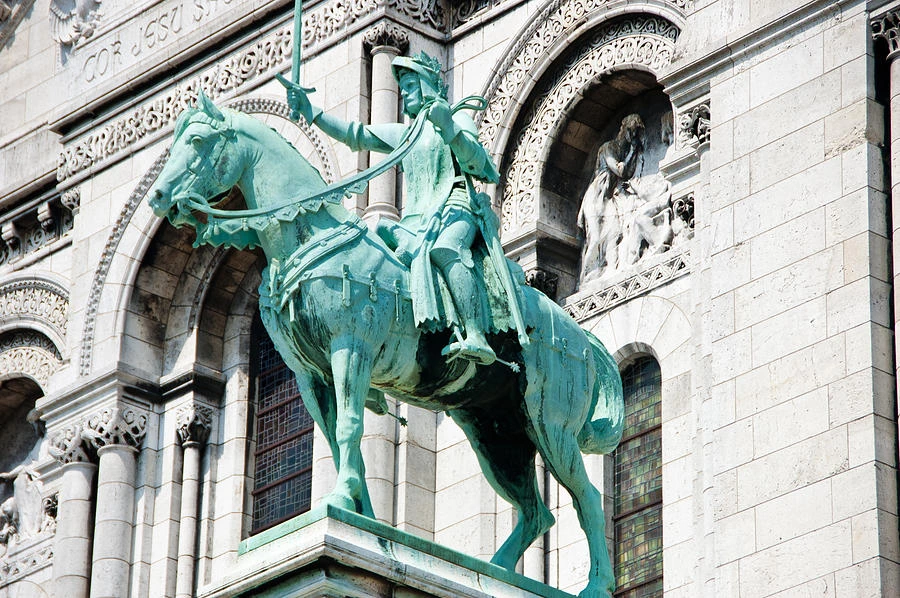
One of the most visited religious monuments in Paris
Paris is home to numerous religious monuments, but few captivate visitors quite like the Basilica du Sacré Coeur. This architectural gem stands as a testament to beauty and endurance, enchanting all who lay eyes upon it. Unlike its counterparts from the Renaissance era, the Basilica's construction occurred merely a century ago, yet it has become one of the most popular religious landmarks in Paris, second only to the iconic Notre Dame Cathedral.
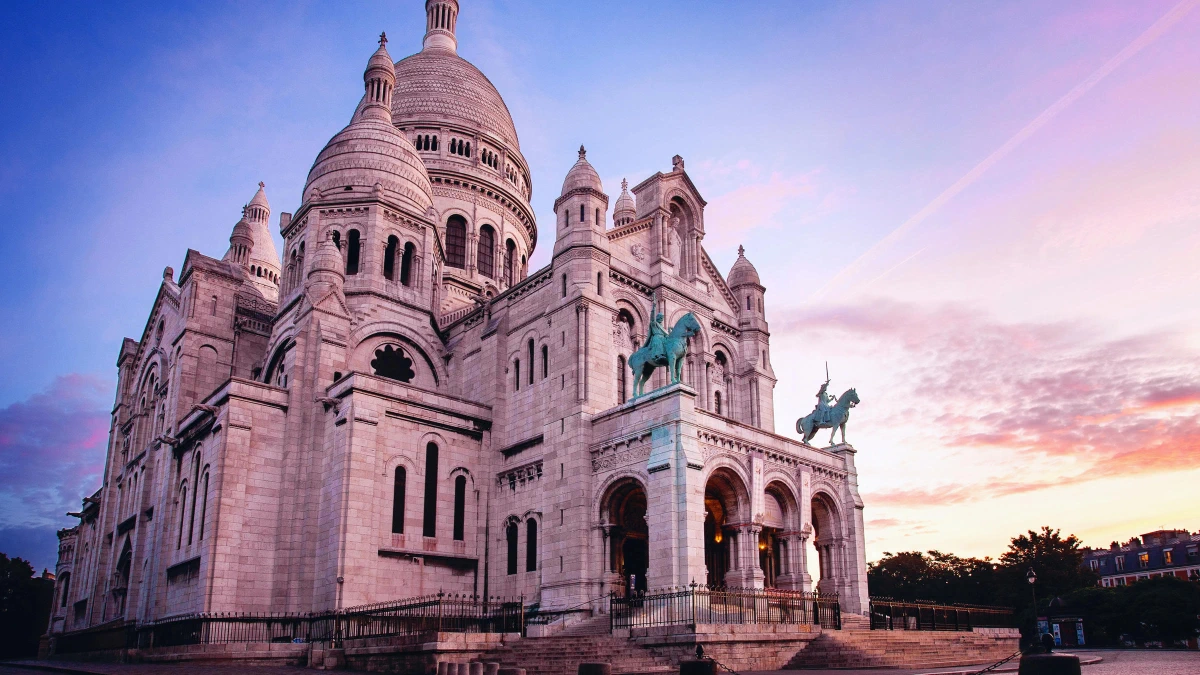
The Basilica's allure lies not only in its age but in its pristine appearance, unaffected by the passage of time and the city's pollution. An intriguing secret resides within its walls: the stones used in its construction possess a remarkable ability to secrete a white substance called "cullet." When rain graces the heavens, this enchanting phenomenon transforms the building, imbuing it with a resplendent white hue that mesmerizes onlookers.
Prepare to be astounded as you discover the Basilica du Sacré Coeur, a cherished masterpiece that defies expectations and continues to leave an indelible mark on the hearts of all who visit.
The peaceful vibe of an amazing church
The Basilica exudes a serene and tranquil atmosphere that captivates visitors from all walks of life. As one approaches the majestic structure, the gentle chiming of church bells fills the air, creating a harmonious melody that resonates with the soul. The pristine white exterior of the basilica stands in stark contrast to the vibrant cityscape, offering a visual retreat from the hustle and bustle of Parisian life.
Stepping inside, the hushed whispers and soft footsteps echo through the grand interior, further enhancing the peaceful ambiance. Sunlight filters through the stained glass windows, casting colorful patterns on the marble floor, evoking a sense of divine tranquility. The sacred aura of the Sacré-Coeur Paris invites visitors to pause, reflect, and bask in the serenity that permeates every corner of this remarkable church.
In addition to its architectural splendor, the Sacré-Coeur Paris possesses an inherent spiritual energy that instills a profound sense of peace in all who enter. The reverent atmosphere is palpable, as visitors find solace in the solemnity and sanctuary offered by this iconic place of worship. Whether one seeks a moment of personal reflection, a spiritual connection, or simply a respite from the outside world, the Sacré-Cœur Paris provides a sanctuary of calm and tranquility.
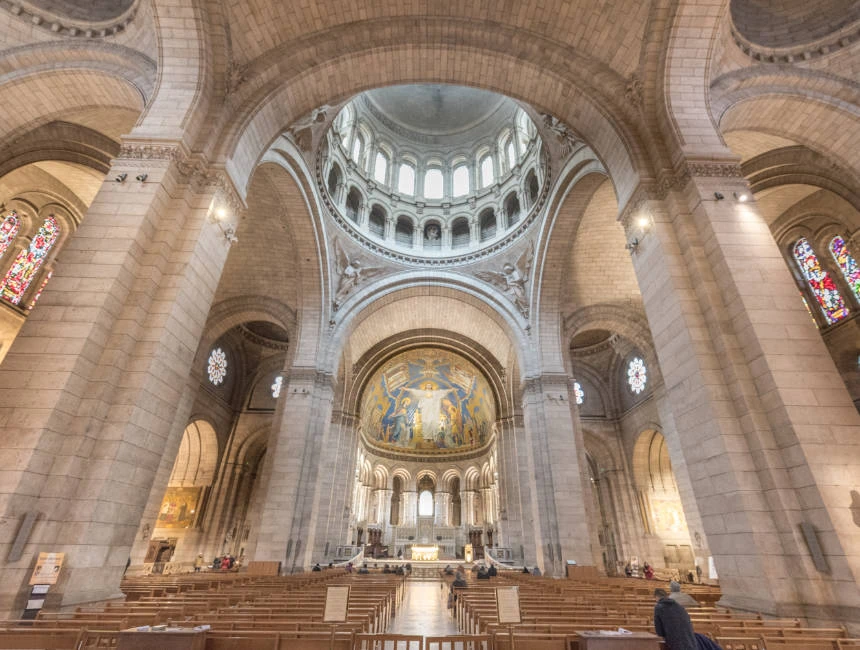
The gently swaying candles, flickering in the dimly lit alcoves, add a touch of warmth and serenity to the ambiance, inviting individuals to engage in quiet contemplation or heartfelt prayer. As visitors ascend the steps of the basilica, they are rewarded with breathtaking panoramic views of the city, further enhancing the peaceful vibe that permeates this magnificent church. The Sacré-Coeur Paris is not merely a place of architectural magnificence; it is a haven of peace that envelopes the hearts and minds of all who have the privilege to experience its remarkable tranquility.
The interior of Sacré-Coeur Basilica in Paris
Stepping inside Sacré-Coeur, visitors are immediately struck by the vastness of the nave, which stretches before them in all its grandeur. The use of Romanesque arches, soaring columns, and intricate mosaics evokes a sense of harmony and spiritual elevation. The stunning ceiling, adorned with magnificent frescoes depicting biblical scenes and celestial beings, serves as a visual feast, inviting the eyes to wander in admiration.
The ambulatory, with its graceful arches and delicate stained-glass windows, encircles the sanctuary, providing a serene path for contemplation. The rose window, located above the main entrance, bathes the interior in a kaleidoscope of vibrant colors when illuminated by the sun's rays, casting an ethereal glow upon the space.
Symbolism and Devotion
Every corner of Sacré-Coeur resonates with symbolic meaning and spiritual devotion. The sanctuary, adorned with precious materials and adorned with sacred objects, serves as the focal point of the basilica. The high altar, featuring a magnificent marble canopy, embodies the central place of worship. Its exquisite design and meticulous craftsmanship symbolize the reverence and adoration offered to the divine.
The apse, dedicated to the Sacred Heart of Jesus, is an intimate and contemplative space. The statue of Christ, offering his heart to humanity, stands as a powerful representation of divine love and compassion. It is a poignant reminder of the basilica's primary purpose: to foster devotion and inspire spiritual reflection.
Atmosphere of Serenity
Sacré-Coeur exudes an atmosphere of profound serenity and tranquility, beckoning visitors to escape the chaos of the world outside. The gentle lighting, filtering through the stained-glass windows, casts a soft glow, creating an ambiance that encourages introspection and inner peace. The hushed whispers of prayers, the faint scent of incense, and the occasional strains of sacred music all contribute to the sanctuary's sense of divine connection.
Decor and Height - Climbing up to the Dome
Prepare to be mesmerized by the exquisite decor and towering height of the Sacré Coeur. Once you step inside this magnificent landmark, you will find yourself rendered speechless. The sight of a colossal mosaic, accompanied by the resounding melodies of a grand Cavaillé-Coll organ, and the presence of hidden treasures within one of the crypts, will undoubtedly satiate your curiosity.
But wait, there's more! If you yearn for a greater vantage point, brace yourself to conquer 234 spiraling steps that will lead you to the basilica's majestic dome. Soaring to a remarkable height of 83 meters, it offers unparalleled panoramas of Paris that will take your breath away. On a clear day, the expansive view stretches as far as 30 kilometers, revealing the magical splendor of the French capital in all its glory. With the aid of binoculars, you can even behold the iconic landmarks of Paris, such as La Defense, Montparnasse Tower, the Panthéon, the Bois de Vincennes, the Buttes-Chaumont, and the basilica of Saint-Denis.
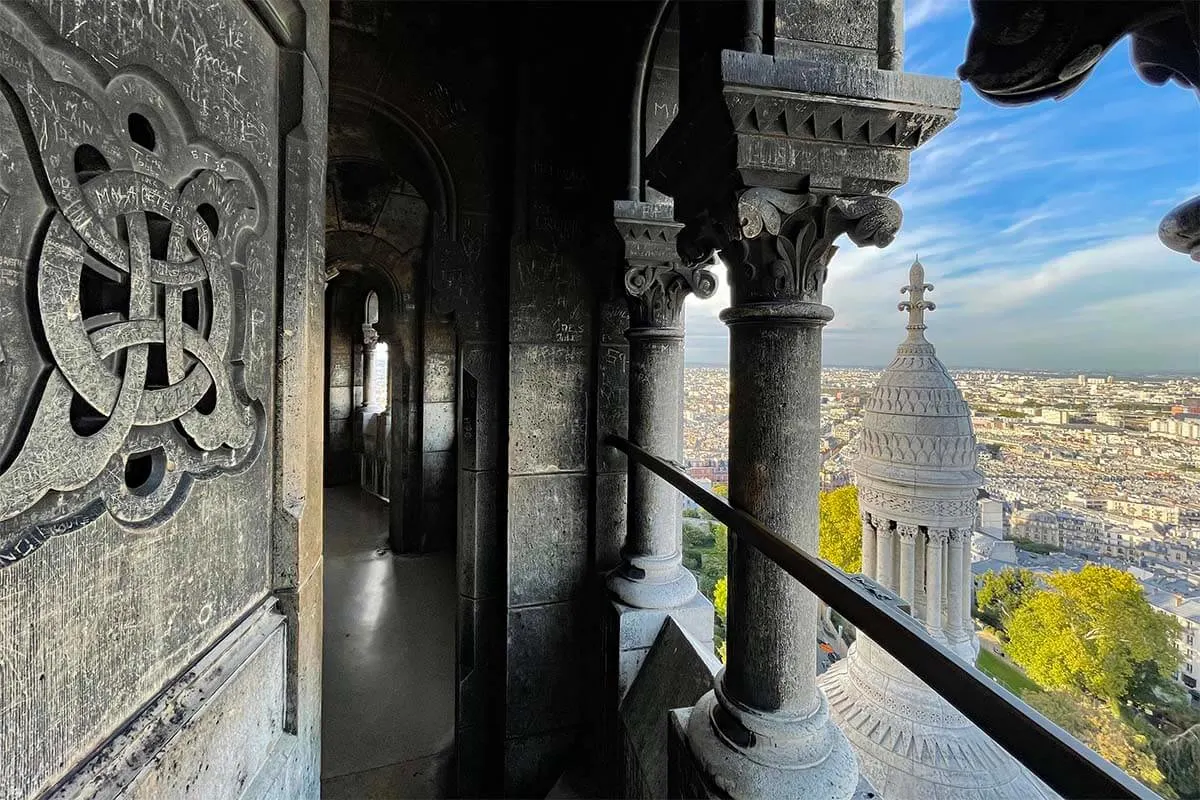
However, the Sacré Coeur doesn't cease to astonish with just its height. Direct your gaze upward, and you'll discover another captivating surprise—the bell tower, seemingly defying the laws of gravity. Nestled within this architectural marvel is the most renowned bell in all of France, known as "La Savoyarde." Weighing a staggering 19 tonnes, this masterpiece was a generous gift from the four dioceses of Savoie.
The Grand Organ of Sacré Coeur Paris
Paris, France, and all of Europe regard the grand pipe organ of the Basilica of Sacré-Coeur de Montmartre as an awe-inspiring masterpiece. This magnificent instrument, constructed in 1898, stands as the final creation of the renowned Aristide Cavaillé-Coll.
Originally commissioned by Baron Albert de l'Espée for his vast château in Biarritz, he spared no expense to acquire the absolute best. After a few years, the organ found its way into the hands of Charles Mutin, Cavaillé's successor, who subsequently sold it to the Basilica in 1919.
Featuring four keyboards, a pedalboard, and an impressive array of 78 stops, this instrument still retains its original mechanical key actions. Its imposing size, exceptional craftsmanship, and unmatched sound quality earned official recognition from the French state, classifying it as a national monument in 1981.
Over the years, the grand organ of the Sacré-Coeur Paris has undergone numerous restorations. However, the most recent endeavor, which commenced in 1985, unfortunately remains incomplete. Only the severely damaged pneumatic components have been replaced, while the remaining parts have succumbed to wear and tear, rendering them unusable. The pipes, now coated in a thick layer of dust, suffer a detrimental impact on pitch and timbre.
Consequently, the organ finds itself in an advanced state of decay. Despite its condition, this instrument continues to resound regularly, accompanying the six weekly office in a bustling building that serves as an emblem of Paris and a renowned tourist destination. It holds the distinction of being the second most widely heard pipe organ worldwide, surpassed only by that of Notre Dame.
Organists who have had the privilege of playing this extraordinary instrument can attest to the countless French and foreign visitors, as well as fellow musicians, who marvel at its exquisite design and unparalleled sound quality. Undeniably, this instrument stands as an invaluable part of France's cultural heritage. The esteemed organists entrusted with its care are Claudine Barthel, Philippe Brandeis, and Gabriel Marghieri.
Today, the grand organ faces an urgent need for restoration, lest its glorious music fade away. Both the organ and the church itself have received national recognition as landmarks.
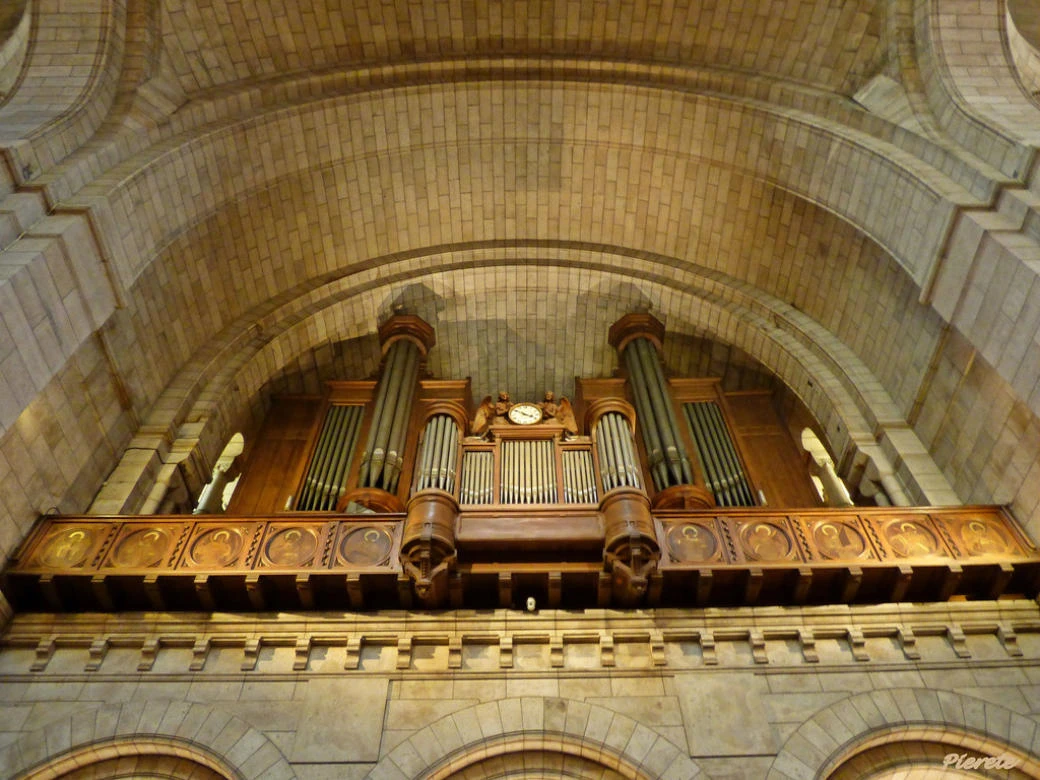
The Bells of Sacré Coeur Paris
The Basilica of the Sacred Heart of Montmartre boasts a remarkable belfry housing a collection of five bells. Among them, four small bells named Félicité, Louise, Nicole, and Elisabeth hold their place. These bells originally belonged to the church of Saint-Roch but were moved to the basilica in 1969.
Positioned below the quartet of bells is an enormous bourdon known as "The Savoyarde," proudly holding the title of the largest bell in all of France. The bourdon's full name is "Françoise Marguerite of the Sacred Heart of Jesus," and it was meticulously cast on May 13, 1891, by the illustrious Paccard foundry, renowned for the craftsmanship of the Dynasty of Georges, Hippolyte-Francisque, and Victor, also known as "G & F," in Annecy-le-Vieux.
"The Savoyarde" itself chimes solely on momentous religious occasions, most notably during Easter, Pentecost, Ascension, Christmas, Assumption, and All Saints' Day. Its resounding toll can be heard from a staggering distance of 10 kilometers. This magnificent bell ranks as the fifth largest in Europe, positioned just below the Petersglocke of Cologne (Germany), the Olympic Bell of London, Maria Dolens of Rovereto (Italy), and the Pummerin of Vienna (Austria).
It carries a weight of 18,835 kilograms, measuring 3.03 meters in diameter with an outer circumference of 9.60 meters. The base thickness amounts to 22 centimeters, while the bell leaf alone weighs 850 kilograms. When accounting for its accompanying accessories, the official weight totals 19,685 kilograms. This exceptional bell was a generous gift from the four dioceses of Savoy and embarked on its journey to the basilica on October 16, 1895, drawn by a team of 28 majestic horses. In the late 1990s, an observant eye discovered a notable crack in the bell, which prompted attention and care.
The Top Attractions Within the Sacré Coeur Paris
The largest mosaic in France
Prepare to be captivated as you step foot inside the magnificent Sacre Coeur. Your gaze will be immediately drawn to the awe-inspiring mosaic embellishing the ceiling above the altar. Its sheer grandeur will leave you breathless, just as it did to me when I first entered.
Architect Luc-Olivier Merson, in the year 1922, poured his artistic brilliance into crafting this masterpiece that portrays the resurrected Jesus Christ. Adorned with a Latin inscription that reverently translates to "to the sacred heart of Jesus from a fervent, penitent, and thankful France," it stands as a testament to faith and devotion.
Expansive and majestic, the mosaic spans an impressive area of 480m2. Within its intricate design, you will encounter the divine figures of Joan of Arc, the Virgin Mary, and Saint Michael—patrons revered for their guardianship over France. Furthermore, the mosaic bears an inscription of the word "grateful," added after the ravages of the First World War.
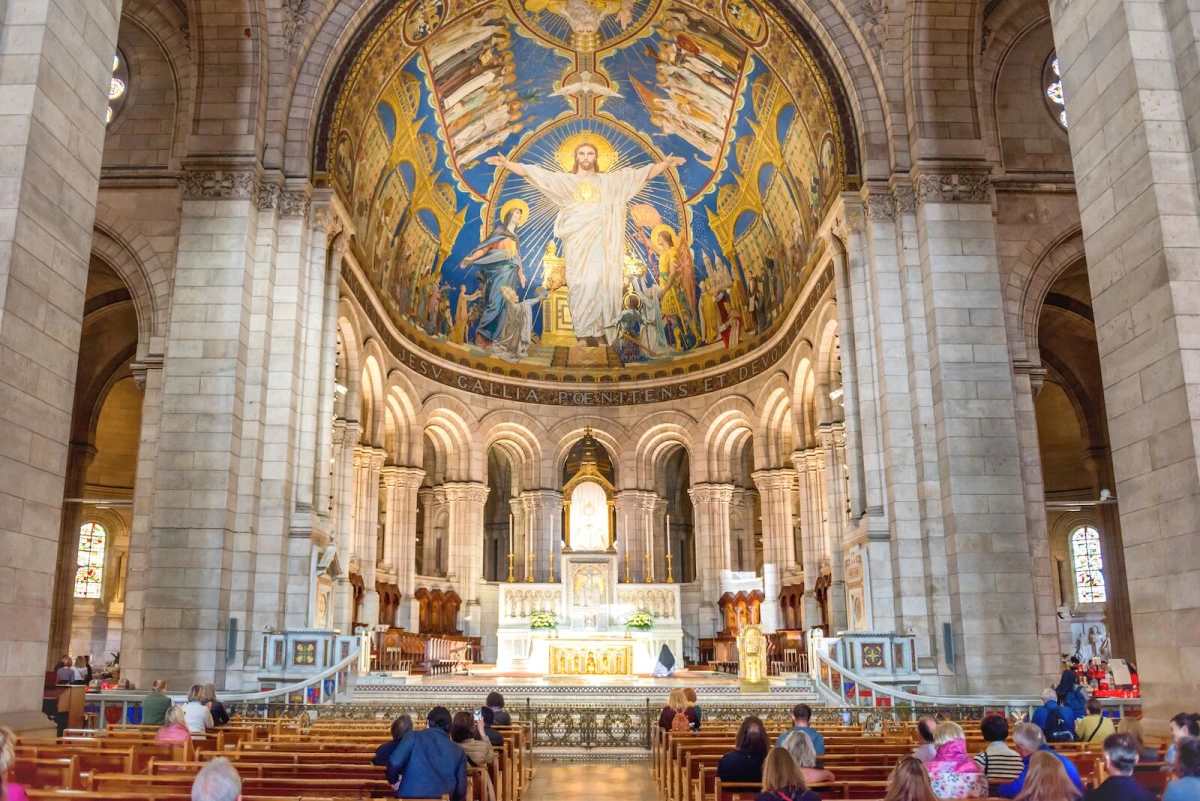
Notably, this remarkable work of art not only claims the title of France's largest mosaic but also stands among the world's most monumental creations. Its magnificence knows no bounds.
The crypt
Discover the captivating marvels that lie within the Sacre Coeur crypt. Brace yourself for a mesmerizing encounter with an assortment of statues, each embodying a patron saint. Delve deeper, and you'll unveil a precious relic, believed to hold the Sacred Heart of Jesus Christ. A befitting homage to the Basilica's very name, as "Sacre Coeur" translates to "Sacred Heart" in English.
Among the illustrious patron saint statues stands the enigmatic figure of Saint Denis. Picture the tale of this valiant soul, the erstwhile Bishop of Paris. Martyred for his unwavering Christian devotion, he met his fate through decapitation in the Montmartre district. Legend reverberates with the account of Saint Denis, resolutely marching through Montmartre's cobblestone pathways, clutching his severed head, fervently spreading the divine word. France hails his memory and celebrates him as the esteemed Patron Saint of Paris and the nation itself. For an in-depth exploration of Saint Denis, venture forth to the remarkable La Crypte du Martyrium de Saint Denis, nestled at the foot of Montmartre.
Within the crypt's hallowed confines, myriad tombs, urns, and memorials await your reverent gaze. Notably, a magnificent statue stands tall, paying tribute to the gallant priests and religious figures who valiantly sacrificed their lives during the tumultuous upheavals of two world wars.
The grand organ
In the enchanting year of 1898, the illustrious Aristide Cavaillé-Coll envisioned and meticulously crafted the resplendent grand organ that now graces the sacred halls of the Sacre Coeur. Originally intended for the stately chateau of Baron Albert de l’Espée in the charming realm of Biarritz, France, destiny beckoned and the organ embarked on a remarkable journey. In 1919, it found its rightful home within the embrace of the Sacre Coeur, bestowed with an aura of profound reverence.
A symphony of exquisite artistry, the organ captivates hearts and minds with its ethereal beauty and commanding presence. The French State, recognizing its magnificence, bestowed upon it the esteemed title of a national monument in the cherished year of 1981. Alas, the passage of time has taken its toll, and the grand organ now languishes in a state of distress, yearning for restoration.
Fear not, for hope and determination guide our hands as we embark on a noble mission to revive this architectural masterpiece. With fervent dedication, plans to mend the organ have been set into motion, resonating with the promise of a glorious renaissance. However, such an undertaking requires a collective effort, and thus, the Sacre Coeur humbly beseeches your benevolence. Your gracious contributions, like harmonious notes in an opus, shall breathe life into the weary soul of this instrument, ensuring its timeless melodies endure for generations to come.
On the Caribbean island of Martinique - also under French jurisdiction - there is a little brother to the basilica. A scaled-down replica of the Sacré Coeur was built in 1915 as a tribute to the inhabitants who were made stateless by the eruption of a volcano there.
The largest bell in France
In the heart of the majestic bell tower, known as the campanile, resides France's grandest bell! Standing proudly as the second tallest structure in Paris, surpassing all but the iconic Eiffel Tower. Isn't it fitting that the largest bell in the nation finds its home within this lofty pinnacle?
Affectionately named La Savoyarde, this bell was a generous gift from four dioceses in Savoy to the Sacre Coeur. Transporting this colossal treasure was no easy feat, requiring a formidable team of 28 horses. The renowned Paccard bell-foundry in Annecy skillfully crafted this awe-inspiring bell, weighing nearly 19 kilograms and boasting a remarkable diameter of 3 meters. As if the bell itself wasn't astounding enough, its clapper weighs a staggering 850 kilograms. Spare a thought for those hardworking horses!

Initially, this magnificent bell chimed joyously on momentous religious occasions such as All Saints Day and Christmas. Sadly, in the late 1990s, a troublesome crack began to mar its resounding melody. Yet, when the bell does ring, its powerful toll carries across a radius of nearly 10 kilometers, captivating all who hear its magnificent call.
The impressive bronze altar of Sacré Coeur Paris
Prepare to be captivated by the mesmerizing bronze altar nestled inside the majestic Sacre Coeur Basilica. Drawing inspiration from the Cluny Abbey in Burgundy, France, this remarkable centerpiece holds a profound significance. Above it, the Blessed Sacrament illuminates the space, a radiant beacon of divine devotion. Since its inception in 1885, the perpetual adoration of the Blessed Sacrament has graced this sacred sanctuary without interruption. As you step into the chapel, a serene ambiance envelops you, urging introspection and prayer. Remember, the sanctity of this place demands reverence, prohibiting photography to preserve the Basilica's sacred purpose.
In a delightful twist of fate, I had the privilege of attending a mass at the Sacre Coeur last year. Even as someone who doesn't possess strong religious convictions, I found myself enchanted by the enchanting spectacle that unfolded at the resplendent altar.
The names of the French citizens that funded the construction of the Sacre Coeur
The construction of the Sacre Coeur in Paris, much like the iconic Eiffel Tower, evoked a mixed response among the populace. While some Parisians considered it unnecessary and feared potential civil unrest, others embraced the idea wholeheartedly.
Interestingly, despite facing opposition, the city of Paris declined to provide financial support for the project. Instead, the estimated cost of 7 million francs (equivalent to over 1 million euros today) was entirely borne by private donations. This resounding show of support revealed a substantial number of French citizens eager to contribute to the Basilica's construction.
To incentivize donations, a unique approach was adopted. Contributors were promised a personalized brick within the Basilica, bearing their names as a lasting testament to their generosity. Today, one can find a trove of names engraved on these bricks, representing the dedicated individuals who financed the creation of this remarkable monument.
Exploring Sacré Coeur Paris and Its Surroundings
A visit to Sacré Coeur Paris offers not only an opportunity to marvel at the basilica's beauty but also a chance to explore the vibrant neighborhood of Montmartre and its surrounding attractions. Here are some key highlights:
Montmartre: An Artistic Haven
Montmartre, the neighborhood surrounding Sacré Coeur Paris, has long been an artistic haven. Its cobbled streets, quaint cafes, and bohemian ambiance have inspired numerous artists, including Pablo Picasso and Vincent van Gogh. Take a leisurely stroll through Montmartre's charming streets, and you'll find yourself immersed in a world of creativity and history.
Place du Tertre: The Artist's Square
One of the most famous squares in Montmartre is Place du Tertre. This bustling square is teeming with artists, offering visitors a chance to have their portraits sketched or to purchase unique artworks as souvenirs. Immerse yourself in the lively atmosphere of Place du Tertre and witness the artistic spirit that continues to thrive in this historic neighborhood.

Moulin Rouge: A Legendary Cabaret
No visit to Montmartre would be complete without experiencing the world-famous Moulin Rouge. This iconic cabaret has been entertaining audiences since 1889, known for its extravagant shows, dazzling costumes, and vibrant can-can dancers. Indulge in a night of unforgettable entertainment at the Moulin Rouge and witness the allure of Parisian nightlife.
Conclusion
Sacré Coeur Paris stands as a beacon of faith, artistry, and history in the heart of Paris. Its grand architecture, panoramic views, and cultural significance make it a must-see destination for anyone visiting the French capital. From the tranquility of the basilica to the vibrant streets of Montmartre, a journey to Sacré Coeur Paris promises an unforgettable experience filled with beauty, spirituality, and the timeless allure of Paris.
FAQs
What is the best time to visit Sacré Coeur Paris?
The best time to visit Sacré Coeur Paris is during the early morning or late evening when the crowds are smaller, and you can enjoy a peaceful ambiance. Avoid weekends and peak tourist seasons to fully appreciate the tranquility of this sacred place.
Is there an admission fee to enter Sacré Coeur Paris?
No, entry to Sacré Coeur Paris is free. However, there may be fees for accessing certain areas within the basilica, such as the dome or the crypt. Check the official website for up-to-date information on fees and opening hours.
Are there any restrictions on photography inside the basilica?
Unfortunately, photography is not allowed unless you get special permission from the church.
Can I climb to the top of Sacré Coeur Paris?
Yes, visitors have the option to climb the dome of Sacré Coeur Paris, offering panoramic views of the city. However, please note that there are approximately 300 steps to reach the top, so be prepared for a climb. The breathtaking views from the dome make it well worth the effort.
What are some nearby attractions to visit after exploring Sacré Coeur Paris?
After exploring Sacré Coeur Paris, you can visit other popular attractions in the vicinity, such as the vibrant Pigalle district, the famous Parisian cabaret Le Chat Noir, or the historic Saint-Pierre de Montmartre church. Each of these attractions offers a unique glimpse into the cultural richness of the Montmartre neighborhood.
Can I attend a mass or religious service at Sacré Coeur Paris?
Yes, Sacré Coeur Paris is an active place of worship, and visitors are welcome to attend mass or religious services. The basilica holds regular services throughout the week, and the sacred ambiance adds to the spiritual experience of your visit.
Site location: 35 Rue du Chevalier de la Barre, 75018 Paris
GPS coordinates: 48.886140, 2.343131
Google Photos: Click here
For more content and exciting articles, follow our site, where we regularly update our column to bring you the best ideas for events or things to do in Paris!






